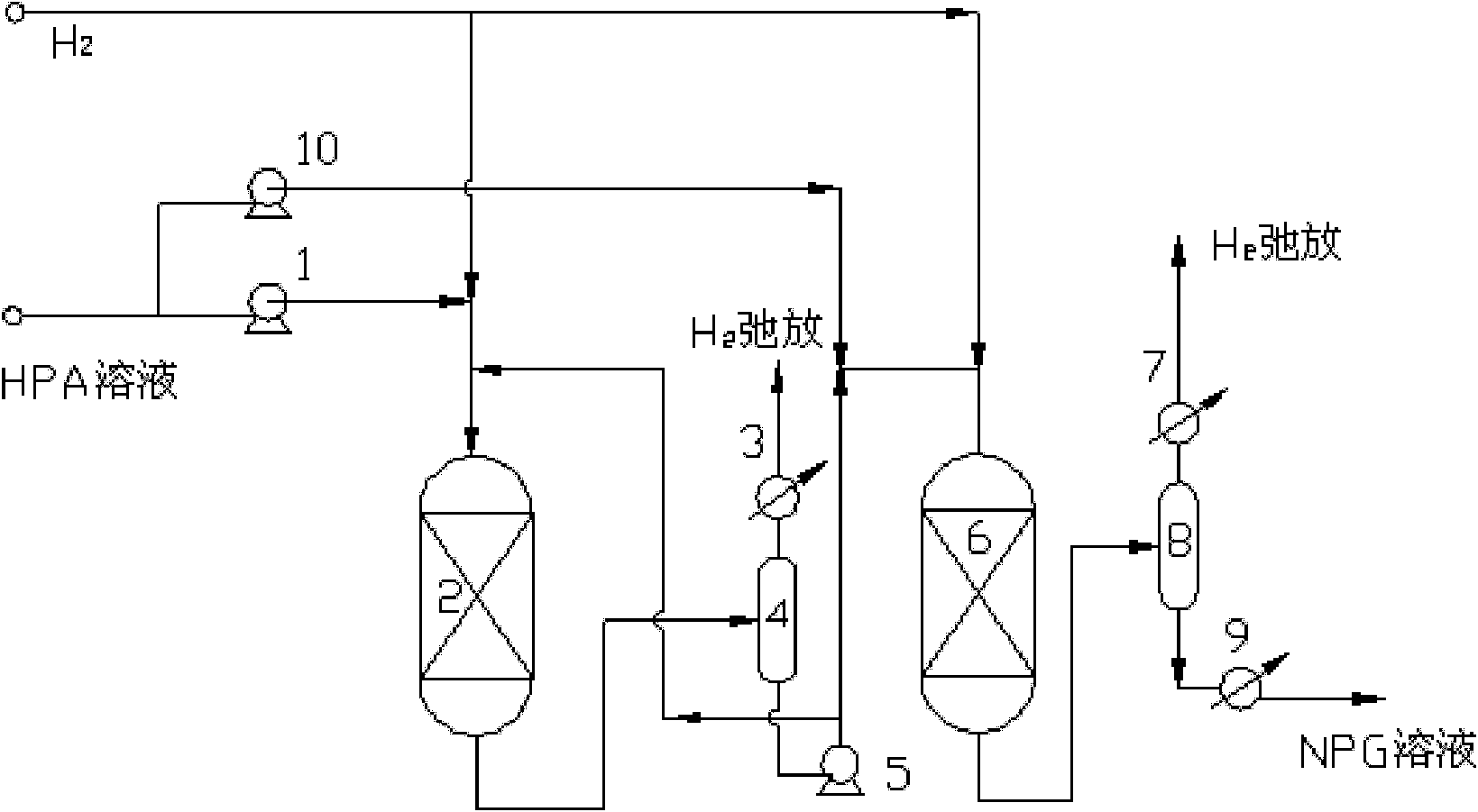Two-step-method hydrogenation process for preparing neopentyl glycol
A technology of neopentyl glycol and hydrogenation reaction, applied in the preparation of hydroxyl compounds, preparation of organic compounds, chemical instruments and methods, etc., can solve the problems of increasing methanol energy consumption, decreasing HPA yield, etc. The effect of strong anti-toxic ability and low price
- Summary
- Abstract
- Description
- Claims
- Application Information
AI Technical Summary
Problems solved by technology
Method used
Image
Examples
Embodiment 1
[0069] Carry out the hydrogenation reaction of HPA in continuous spray bed reactor, experiment arrangement is as follows:
[0070] Reactor: stainless steel tubular reactor with an inner diameter of 10mm and a length of 400mm;
[0071] Catalyst: Cu-Zn-Al, prepared by co-precipitation method, the molar ratio of copper and aluminum in the catalyst is 1.0:1.34; the molar ratio of copper and zinc is 1.0:0.55, and the catalyst is crushed to 20-40 mesh
[0072] Feed: Crude HPA without any purification operations from the acetalization reaction catalyzed with triethylamine
[0073] Solvent: a mixture of main components NPG and water (from hydrogenation product return)
[0074] Catalyst dosage: 2.56g
[0075] Liquid feed rate: 23.3g / hr
[0076] Liquid hourly space velocity: WHSV=9.1g / gcat / hr
[0077] HPA liquid hourly space velocity: 1.0g / gcat / hr
[0078] Temperature: 141°C
[0079] Pressure: 3.5MPa
[0080] Mode of operation: The feed is continuously pumped through the reactor ...
Embodiment 2
[0088] Carry out the hydrogenation reaction of HPA in continuous spray bed reactor, experiment arrangement is as follows:
[0089] Reactor: stainless steel tubular reactor with an inner diameter of 10mm and a length of 400mm;
[0090] Catalyst: Cu-Zn-Al-Mn, prepared by co-precipitation method, containing 39.7wt% of copper oxide, 21.0wt% of zinc oxide,
[0091] Aluminum oxide 34.1wt%, manganese oxide 5.2%, catalyst crushed to 20-40 mesh;
[0092] Feed material: crude HPA solution without any purification operation obtained from the acetal reaction of isobutyraldehyde and formaldehyde, the acetal reaction is catalyzed by triethylamine;
[0093] Solvent: a mixture of main components NPG and water (from hydrogenation product return);
[0094] Catalyst dosage: 2.52g;
[0095] Temperature: 135°C;
[0096] Pressure: 3.5;
[0097] Liquid feed rate: 4.6g / hr;
[0098] Airspeed: WHSV=1.84g / gcat / hr
[0099] HPA liquid hourly space velocity: 0.2g / gcat / hr
[0100] Mode of operation:...
Embodiment 3
[0108] Equivalent to the first hydrogenation reactor as described in Example 1, the hydrogenation product obtained from Example 1 is distributed as follows: about 85 wt% is directly mixed with the reaction solution obtained from the acetal reaction of isobutyraldehyde and formaldehyde, It is formulated as raw material for the first hydrogenation reactor, and the rest enters the second hydrogenation reactor for further hydrogenation conversion.
[0109] table 3
[0110]
[0111]
[0112] The second hydrogenation reactor experimental arrangement is as follows:
[0113] Carry out the hydrogenation reaction of HPA in the continuous spray bed reactor;
[0114] Reactor: stainless steel tubular reactor with an inner diameter of 10mm and a length of 400mm;
[0115] Catalyst: Cu-Zn-Al-Mn, prepared by co-precipitation method, the catalyst contains 39.7wt% copper oxide, 21.0wt% zinc oxide, 34.1wt% aluminum oxide, 5.2% manganese oxide, and the catalyst is crushed to 20-40 mesh;
...
PUM
| Property | Measurement | Unit |
|---|---|---|
| The inside diameter of | aaaaa | aaaaa |
| Length | aaaaa | aaaaa |
Abstract
Description
Claims
Application Information
 Login to View More
Login to View More - R&D
- Intellectual Property
- Life Sciences
- Materials
- Tech Scout
- Unparalleled Data Quality
- Higher Quality Content
- 60% Fewer Hallucinations
Browse by: Latest US Patents, China's latest patents, Technical Efficacy Thesaurus, Application Domain, Technology Topic, Popular Technical Reports.
© 2025 PatSnap. All rights reserved.Legal|Privacy policy|Modern Slavery Act Transparency Statement|Sitemap|About US| Contact US: help@patsnap.com



